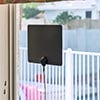We may earn commissions when you buy from links on our site. Why you can trust us.
Samsung S800D Soundbar Review: Big Sound, Ultra Slim Profile
When Samsung introduced its first ultra-slim model, the HW-S800B, it impressed me with its audio engineering, combining a 3.1.2 Dolby Atmos soundbar with a wireless subwoofer in an astonishingly slim package. Now, the next-generation Samsung HW-S800D Ultra Slim Soundbar ($899.99) is here, and I've had the opportunity to test it firsthand. I can confidently say that Samsung has built upon the solid foundation of the S800B, refining the design and adding features that make the S800D an even more compelling choice for those seeking a sleek, high-performance soundbar.
The S800D takes the ultra-slim form factor to a new low (in a good way). It measures just 1.4" in height, 45.6" in width, and 1.5" in depth. This incredibly thin profile allows the soundbar to blend seamlessly with your TV, virtually disappearing beneath the screen. When I placed the S800D under the 65-inch Samsung Neo QLED N90C I used for testing, it was remarkable how much space remained between the top of the soundbar and the bottom of the TV. This setup avoids the cramped look often associated with soundbars, and when mounted on the wall, the S800D has a minimal visual impact.
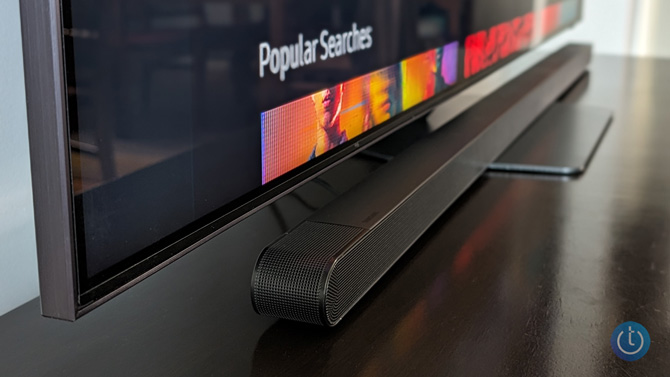
One of the notable upgrades from the S800B is the inclusion of an HDMI eARC port, enabling lossless audio transmission for an even more immersive sound experience. The S800D also offers wireless connectivity through WiFi and Bluetooth, including the ability to receive Wireless Dolby Atmos from compatible Samsung TVs. During my testing, I found that the wireless connection was stable and easy to establish, with no noticeable lag or sync issues.
Read more: The New Samsung S800B Defines the Ultra-Slim Soundbar Category
Throughout my hands-on experience with the Samsung HW-S800D, I was consistently impressed by its ability to deliver room-filling, immersive sound despite its ultra-slim profile. Whether watching movies, streaming music, or gaming, this soundbar proved to be a versatile and capable performer, elevating the audio experience far beyond what most built-in TV speakers can offer.
| + Pros | – Cons | ||
|
|
||
|
|||
Features and specifications
The S800D is a 3.1.2-channel system featuring three front channels, one subwoofer channel, and two up-firing channels for Dolby Atmos height effects. In total, it delivers 330W of power, with 200W in the subwoofer and 110W from the soundbar. This configuration enables the soundbar to create a convincing 3D surround sound experience, immersing you in the action.
As a high-end soundbar, it's no surprise the S800D is compatible with Q Symphony, a technology that syncs the soundbar with select Samsung TV speakers to create an expanded, more immersive soundstage. In my experience, this feature worked seamlessly, elevating the overall audio experience when paired with a compatible TV.
Read more: Samsung Music Frame Review: An Innovative Blend of Sound and Style
The SmartThings app, available for both Android and iOS devices, provides access to a wide range of customization options and advanced features. SpaceFit Sound Pro (upgraded from SpaceFit Sound on the S800B), for example, analyzes your room's acoustics and automatically optimizes the soundbar's performance to suit your space.
The S800D also offers a range of sound modes. Adaptive Sound+ (upgraded from Adaptive Sound on the S800B) analyzes and optimizes audio content scene-by-scene, ensuring clear dialog and rich, detailed sound. Game Mode Pro optimizes the soundbar's settings for immersive gaming, while the Active Voice Amplifier (AVA) ensures clear and intelligible dialog even during action-packed scenes.
Unpacking and setup
When I first unboxed the Samsung HW-S800D Ultra Slim Soundbar, I was shocked by just how thin the main soundbar unit is. It's so slim that when wrapped in its protective white sleeve, it nearly disappears into the packaging. The compact wireless subwoofer, on the other hand, is more substantial, hinting at its potential for delivering deep, powerful bass.
Installing the S800D in my living room was a breeze. I positioned the soundbar beneath my 65-inch Samsung Neo QLED N90C, which I used for testing purposes. The soundbar's ultra-slim profile allows it to blend seamlessly with the TV, almost disappearing from view.
For my initial setup, I opted for a wired connection using the included micro-HDMI to HDMI cable, which plugs into the soundbar's HDMI eARC port. This single-cable solution simplifies the installation process and ensures high-quality, lossless audio transmission. However, I also tested the S800D's wireless capabilities by connecting it to my TV via WiFi. The wireless setup was equally straightforward, and I experienced no noticeable latency or synchronization issues during my testing.
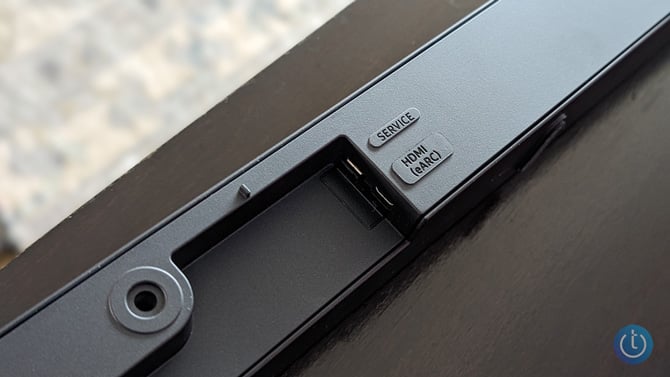
Read more: How to Pick the Best Surge Protector
One of the features I was eager to try out was Q Symphony, which synchronizes the soundbar with compatible Samsung TV speakers to create a more expansive and immersive soundstage. The S800D seamlessly integrated with my N90C, and the results were impressive. The combined audio from the soundbar and TV speakers added an extra layer of depth and dimensionality to the sound, creating a more engaging and lifelike experience.
To fine-tune the S800D's settings and access its full range of features, I downloaded the Samsung SmartThings app on my smartphone. The app automatically detected the soundbar once it was connected to my WiFi network and guided me through the setup process. I found the app to be intuitive and user-friendly, offering a wide array of customization options. One feature I particularly appreciated was SpaceFit Sound+, which analyzed my room's acoustics and optimized the soundbar's performance accordingly. This ensured that I was getting the best possible sound tailored to my specific listening environment.
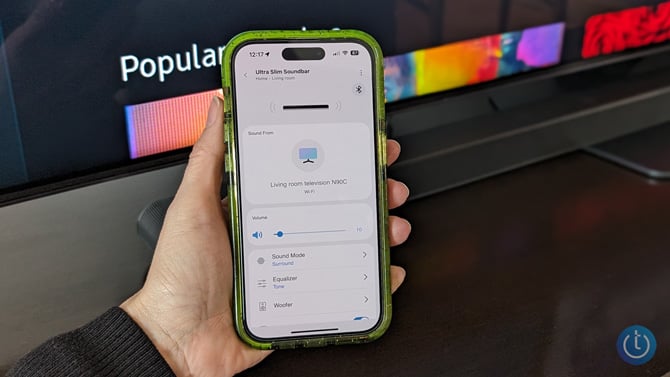
The S800D also offers built-in Amazon Alexa and Samsung's Bixby voice assistants (Google Assistant is not a choice during setup). So, you can control your soundbar hands-free, adjust settings, and even access information like weather reports or news headlines.
The included remote control is well-designed and easy to use, with dedicated buttons for key functions such as volume control, sound mode selection, and subwoofer level adjustment. I also liked the small LED lights on the soundbar itself, which provided clear visual feedback during setup and operation.
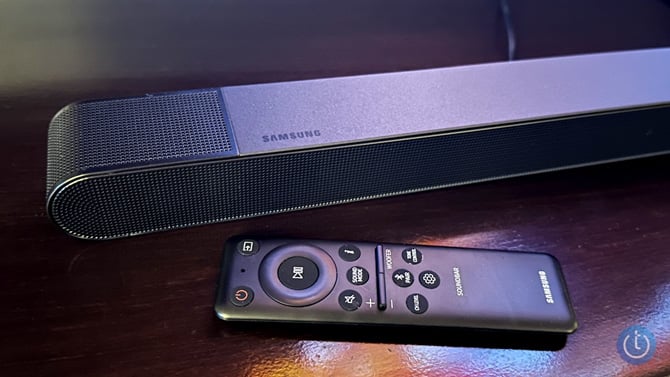
Audio performance
As someone who values high-quality audio, I was eager to put the Samsung HW-S800D Ultra Slim Soundbar through its paces. Despite its remarkably thin profile, I was curious to see how well it would perform across a range of content, from movies to music.
I began my testing with some Dolby Atmos-enabled content, starting with the film The Old Guard. The S800D's ability to create a convincing 3D surround sound experience was noticeable. The up-firing speakers did an excellent job of rendering height effects, adding a sense of verticality to the soundstage. In a particular scene set in a church next to an airport runway, the realistic rumble of jet engines filled my living room, creating the illusion that the planes were flying directly overhead.
Read more: Samsung OLED S95D: The Best OLED Big Screen Yet?
Another standout moment came during a market scene in the film. The S800D masterfully reproduced the background chatter and ambient sounds, enveloping me in the bustling atmosphere of the marketplace. Despite the complex soundscape, the main dialog remained clear and intelligible, never getting lost in the mix.
If you find dialog hard to hear, the Active Voice Amplifier (AVA) feature ensures that voices cut through the background noise. However, I'd advise using it sparingly because dialog can sound artificially loud and detract from the rest of the soundtrack.
The included wireless subwoofer delivered deep, powerful bass that lent weight and impact to action sequences and explosions without overpowering the other elements of the soundtrack.
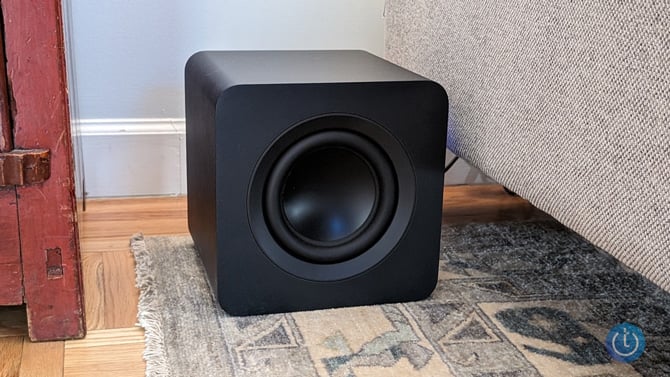
To further test the S800D's capabilities, I experimented with various sound modes. I found that the Adaptive Sound+ mode consistently delivered the best results, dynamically adjusting the audio to suit the content without the need for manual tweaking. However, for those who prefer a more customized experience, the S800D offers a range of sound modes, including Surround, Game, DTS Virtual:X, and Standard, each optimized for different types of content.
As a music lover, I was pleasantly surprised by the S800D's performance when streaming my favorite tunes. The soundbar delivered a well-balanced, detailed sound signature with crisp highs, clear mids, and tight, punchy bass. The inclusion of Dolby Atmos Music support added an extra layer of immersion, creating a more spacious and enveloping listening experience.
Read more: Review of the Samsung Music Frame: An Innovative Blend of Sound and Style
While I didn't personally test the S800D's gaming performance, the soundbar features a dedicated Game Mode Pro, which optimizes the settings for an immersive gaming experience. The soundbar's ability to deliver precise, directional audio and powerful bass makes it an attractive option for gamers looking to enhance their setup.
The bottom line
The Samsung HW-S800D Ultra Slim Soundbar is a remarkable feat of audio engineering, delivering impressive sound quality and immersive features in an astonishingly slim package. As a second-generation product, it builds upon the success of its predecessor, the S800B, while introducing several upgrades to its sound processing and upgrading its input to eARC.
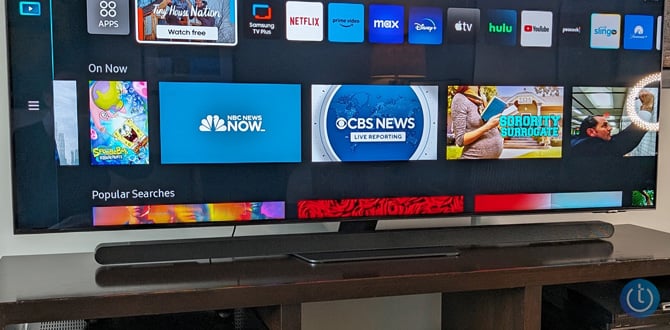
The soundbar's ultra-slim design may limit its overall maximum volume and bass output compared to larger, more conventional soundbars. However, for most living room setups, the S800D provides more than enough power and presence to create an engaging and immersive listening experience.
The Samsung HW-S800D Ultra Slim Soundbar is a compelling combination of sleek design, impressive audio performance, and advanced features. It's the perfect choice for anyone looking to upgrade their TV's sound without sacrificing style or space.
[Image credit: Suzanne Kantra/Techlicious]
For the past 20+ years, Techlicious founder Suzanne Kantra has been exploring and writing about the world’s most exciting and important science and technology issues. Prior to Techlicious, Suzanne was the Technology Editor for Martha Stewart Living Omnimedia and the Senior Technology Editor for Popular Science. Suzanne has been featured on CNN, CBS, and NBC.
















